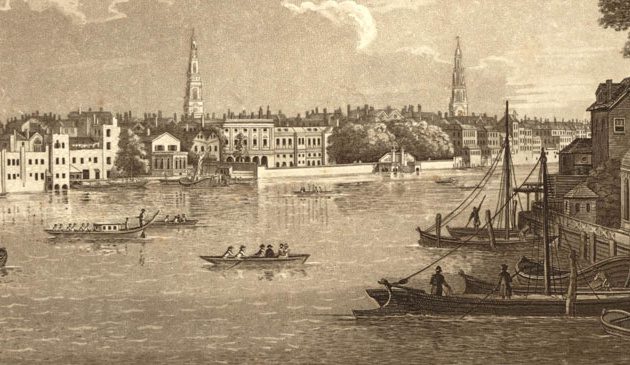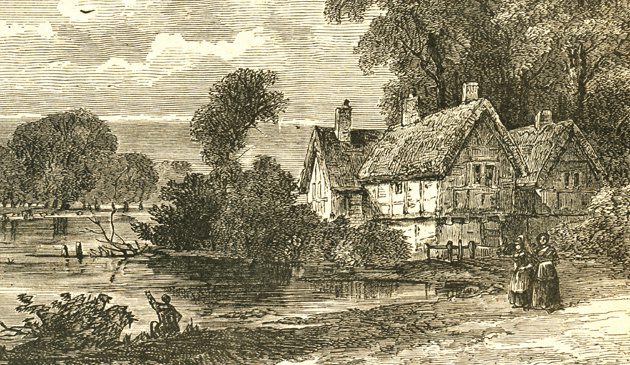Coffee houses, taverns, tea and chocolate

Thomas Garraway’s coffee house in Exchange Alley at Cornhill. It was one of the first to sell tea in London and continued in business for over two hundred years before closing in the 19th century.
By the time tea was brought to Europe by the Portuguese in the mid-16th century it had been grown and drunk in China for around four thousand years. It was from the Portuguese that the Dutch began importing it but when alliances between the two countries were broken at the beginning of the 17th century the latter started bringing tea directly from the Far East in their own ships. Tay as they called it – probably an adaptation of the Chinese name cha – become a fashionable drink to which they added milk and sugar and soon all the wealthier households in Amsterdam had a tea-room.
Tea began to arrive in London during the middle of the 17th century – probably first imported by Henry Bennett, Earl of Arlington – and was drunk at the royal court of Charles II who had experienced it while in exile in Holland. The cost was particularly prohibitive – with Garaway advertising it in 1660 at the vast sum of between six and ten pounds per pound weight from his coffee-house – until it began to be imported directly by the English East India Company. It was not until after the British captured the Dutch settlement of New Amsterdam in 1664 (renamed New York) that it became particularly fashionable in London.
Chocolate was developed by the Mayans in the Central American rainforests who called it cacoa or ‘food of the gods’. The Spanish learnt about it in the early 16th century from the Aztecs to the north who prized it more highly than gold and used the beans as monetary currency, calling it xocolatl. The secret remained with the Spanish for another hundred years until it was mixed with vanilla and sugar, becoming a fashionable drink at the French royal court. The first record of a chocolate drink being sold in London was in 1657 at a shop called The Coffee Mill & Tobacco Roll and around that time cocoa powder also began to be used as an ingredient for making cakes. A heavy import duty was soon imposed, however, and its cost became prohibitive to all except the wealthiest.
Some of the first houses to be rebuilt after the Great Fire of 1666 were let out to ale-house keepers to restart their businesses. The City was then a vast building site and the workmen needed food and drink to keep them going. Soon there were once again plenty of taverns for Londoners and visitors to meet and entertain themselves and their friends, catering for every taste and pocket, serving meals as well as alcohol.
Taverns had originated as private houses, continuing to be laid out with a bar near the doorway where the landlord stood taking orders. At the rear would be a series of small rooms that were then sub-divided by screens to provide privacy for patrons. Many customers were well-known to the landlord for whom he often acted as messenger, banker and business-agent.
“It is a common custom with the lower order of people,” wrote Count Magalotti, a visitor from Tuscany, “rather than the nobility, who are less given to it, after dinner or at public houses, when they are transacting business of any kind, to take tobacco, and smoke, so that there does not pass a day in which the artisans do not indulge themselves in going to the public houses, which are exceedingly numerous, neglecting their work, however urgent it may be.”
In 1728 Sir Nicholas Lawes, Governor of Jamaica, received a gift of eight Arabica Typica coffee seedlings from his counterpart on the French colony of Martinique. From those plants the cultivation of coffee began on the island, harvested by slaves imported from Africa. By the end of the century Jamaica had become one of the leading growers of coffee. In the early 19th century coffee was also grown in the British colonies of Ceylon (Sri Lanka) and India but that ended when the coffee plantations were affected by fungus.
Sources include: John Richardson ‘The Annals of London’; Lisa Jardin ‘On A Grander Scale’; Barry Coward ‘The Stuart Age’; ‘The Travels of Cosmo III’. ‘The Diary of Samuel Pepys”; With thanks to Nigel Pickford for help with proof-reading.
< Go back to Restoration London


